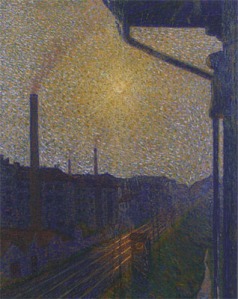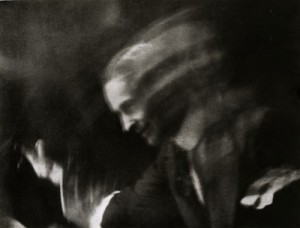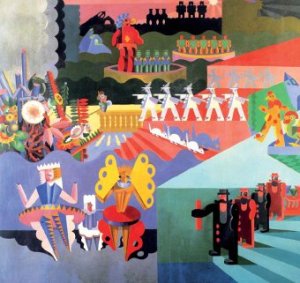Italian Futurism: From Cubism in Motion to Fascism’s Official Style
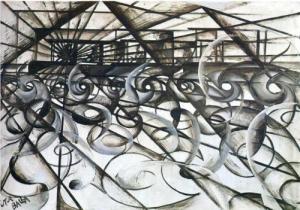
Speeding Car by Giacomo Balla. (Oil and ink on paper mounted on board. 1913. Private collection.) The movement was born when a speeding car crashed. The artists would propel it heedlessly toward a greater crash, one with tragic real world consequences. (All pieces illustrated are exhibited by the Guggenheim unless otherwise noted. For the Italian names of the pieces, see the page “Index to Art.” Clicking on the image will bring up a larger version.)
The Guggenheim Museum in New York is hosting the largest exhibition of Italian Futurist Art ever assembled in the United States. The show is, literally, a dizzying display of the movement designed to embrace modern technology and urbanism, to throw over Romanticism and to envelop the audience, literally and figuratively, by “remaking the universe.” The meticulous setting of the works, the attention to authentic re-creation of the movement’s aspirations and the intelligent curation seem at odds with a movement that arose from a hyped desire to “Burn the museums!” but the contradiction inherent in a museum show of Futurism is no greater than the inherent contradictions of a group of self-promoting artists using traditional art forms to proclaim their fundamental rejection of all art forms. Perhaps more ironic is how a movement, intellectually incorporating all the salient features of proto-Fascism, would eventually betray its own revolutionary aesthetics by slavishly following the flesh-and-blood Fascists. Even art history abounds in irony.
The Originator, F.T. Marinetti

The Founder of Futurism: Filippo Tommaso Marinetti. (ca. 1910. Photographer unknown.) (Not part of Guggenheim exhibition.)
Futurism was birthed by Filippo Tommaso Marinetti, poet, editor and most importantly provocateur. Used to bombast, he proposed to revitalize Italian letters with a manifesto. It appeared, in French, on the front page of the February 20, 1909 issue of Le Figaro (“The Founding and Manifesto of Futurism”). In it he cavalierly tells the story of the events that led him to the insight that changed his life: “Art, in fact, can be nothing but violence, cruelty, and injustice.” And it became his duty, as an artist, to spread these plagues widely.
The conclusion came to him thus: Marinetti had spent the night with his literary colleagues “arguing up to the last confines of logic” until they found themselves early in the morning alone in a quiet flat keenly aware of their solitude at that time. Then abruptly their peace was broken by the sudden rumble of a double-decker trams outside. Soon it was quiet again but on closer listen they could hear distant automobiles roar.
“Let’s go!” I said. “Friends, away! Let’s go! Mythology and the Mystic Ideal are defeated at last. We’re about to see the Centaur’s birth and, soon after, the first flight of Angels!… We must shake at the gates of life, test the bolts and hinges. Let’s go! Look there, on the earth, the very first dawn! There’s nothing to match the splendor of the sun’s red sword, slashing for the first time through our millennial gloom!”
>And so the group went off in Marinetti’s car, manically running “after Death,” as he put it. The speeding car travelled through mixed literary allusions until Marinetti cried: “Let’s break out of the horrible shell of wisdom and throw ourselves like pride-ripened fruit into the wide, contorted mouth of the wind! Let’s give ourselves utterly to the Unknown, not in desperation but only to replenish the deep wells of the Absurd!” With that Marinetti spun his car around and lo before his speeding car were two cyclists arguing with each other, unaware of danger in front of them. Marinetti swerved and crashed the car upside down in the ditch. He was fished out of the muck unharmed—even his car, his beautiful shark, revived, and Futurism was born, at the moment that: “I felt the white-hot iron of joy deliciously pass through my heart!” This taste of ferrous pleasure burning his heart was the metaphor that would guide Futurism.

“Fascism Futurism” by Giovanni Acquaviva, one of serving set of twelve entitled Life of Marinetti (Glazed ceramic, manufactured by Casa Giuseppi Mazzotti, Albisola Marina. 1939. Wolfsonian-Florida International University, Miami Beach, Florida).
But there was more than metaphor. Futurism was full of energy, desire to tear down the past, for sure, but above all the rules. And Marinetti’s manifesto had 11 promises, among which “1. We intend to sing the love of danger, the habit of energy and fearlessness” and “3. Up to now literature has exalted a pensive immobility, ecstasy, and sleep. We intend to exalt aggressive action, a feverish insomnia, the racer’s stride, the mortal leap, the punch and the slap.” And like many of the other movements taking place in Europe, Futurism would glorify violence: “9. We will glorify war—the world’s only hygiene—militarism, patriotism, the destructive gesture of freedom-bringers, beautiful ideas worth dying for, and scorn for woman.” Just so there would be no mistake that he was advocating any sort of acknowledged decency: “10. We will destroy the museums, libraries, academies of every kind, will fight moralism, feminism, every opportunistic or utilitarian cowardice.” How could this movement not become Fascist?
Painters and Others Join the Ranks
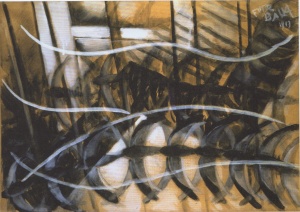
Paths of Movement + Dynamic Sequences by Giacomo Balla (Tempura on paper mounted on canvas. 1913. Gianni Mattiolli Collection on long-term loan to the Peggy Guggenheim Collection, Venice).
At first Futurism was an obscure literary movement. Marinetti had spent some time on the agenda, picked the name “Futurism,” after some deliberation (rejecting “Electricism” and “Dynamism”), and bruted it about with his uniquely confrontational style. He published something of an ideology in a 1908 issue of Poesìa, a “revolution” purely in literary terms. His cause went nowhere until he hyped his roadside revelation a year later. The reboot, filled with youthful energy and contempt for convention, had a better effect.
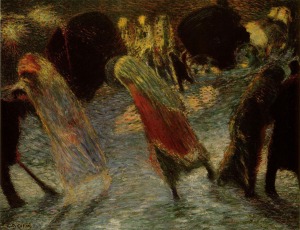
Leaving the Theater by Carlo Carrà. (Oil on canvas. ca. 1910. Estorick Collection, London.) Before the Manifesto, Carrà began as an advanced Post-Impressionist.
Three painters, Carlo Carrà, Umberto Boccioni and Luigi Russolo, were enticed enough by the manifesto that they came to him offering to become another battalion in his Futuristic army. Marinetti, who would prove to be a master promoter and movement builder, enthusiastically accepted their offer. And they issued their own manifesto. In somewhat more straightforward prose, the document exuded the same impatience with convention and bristled with self-assurance. When it was published by Poesìa on February 11, 1910, two more painters added their name to the “Manifesto of the Futurist Painters”—Gino Severini as well as Severini’s and Boccioni’s teacher, Giacomo Balla. These five painters became known as the Futurist Painters. Their Manifesto was as inflammatory as Marinetti’s, and, if anything, it had even less self-awareness:
The cry of rebellion which we utter associates our ideals with those of the Futurist poets. These ideals were not invented by some aesthetic clique. They are an expression of a violent desire which boils in the veins of every creative artist today.
We will fight with all our might the fanatical, senseless and snobbish religion of the past, a religion encouraged by the vicious existence of museums. We rebel against that spineless worshipping of old canvases, old statues and old bric-a-brac, against everything which is filthy and worm-ridden and corroded by time. We consider the habitual contempt for everything which is young, new and burning with life to be unjust and even criminal.
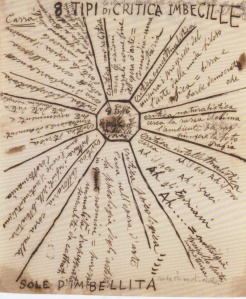
Sun of Idiocy (8 Types of Idiotic Criticism) by Carlo Carrà. (Ink on paper. 1914. Private collection.)
More explicitly than Marietta (although as it turned out, they would prove to less ardent in practice) the painters tethered the movement to a pervading, nationalist resentment of the then current disrespected, dispirited condition of the Italian people, who had fallen considerably from their ancient greatness. Brimming with the radically reactionary programme that Marinetti preached, their manifesto overflows with the arrogant and violent assurance of the later Fascists:
We are sickened by the foul laziness of artists, who, ever since the sixteenth century, have endlessly exploited the glories of the ancient Romans.
In the eyes of other countries, Italy is still a land of the dead, a vast Pompeii, white with sepulchres. But Italy is being reborn. Its political resurgence will be followed by a cultural resurgence. In the land inhabited by the illiterate peasant, schools will be set up; in the land where doing nothing in the sun was the only available profession, millions of machines are already roaring; in the land where traditional aesthetics reigned supreme, new flights of artistic inspiration are emerging and dazzling the world with their brilliance.
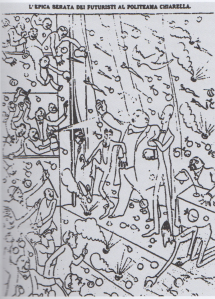
Reaction to the serata at the Politeanma Chiarella, Turin, 1910. Cartoon by Umberto Boccioni (Archivio Giovanni Lista). Onstage from left to right: Carrà, Mazza, Marinetti and Boccioni.
The painters not only joined but enthusiastically built on Marinetti’s publicity strategy of holding public events (serenas) where they baited the audience with inflammatory positions and insulted their taste and intelligence. The painters made the events multi-media, which only turned audience reaction more violent. The serenas became highly publicized events where the audience knowingly participated with ridicule, derision and hostility. But the hostility generated more publicity and stimulated others to attend the next event to participate in the outrage and increase the profile of the artists. The strategy made the movement world-famous at a time when the world was chockfull of movements. Promotion was a singular talent of the Futurists, which some later turned into advertising.
It would not take long before the other arts would take their place within the Futurist scheme. Manifestos were their announcements. Boccioni issued the manifesto for sculpture in 1912. Music, cinema, “noises,” architecture, lust and even war (“the world’s only hygiene” according to Marinetti himself) had their own Futurist manifestos. Finally, and inevitably, in 1915 Balla and Fortunato Depero incorporated everything into Futurism with their manifesto “Futurist Reconstruction of the Universe.” It is that ambition that the Guggenheim exhibit tries to trace chronologically from 1909 to 1944, when the movement, together with Fascism itself, expired in Italy.
A Movement in Search of a Visual Language

Street Light by Giacomo Balla (Oil on Canvas. ca. 1910 (dated 1909 by artist). Museum of Modern Art.) Balla would begin his search for the future and urbanism from the oldest school of the Five: Late Impressionism, which celebrates light and static scenes mainly in the country.
At first, there was nothing particularly redolent of Fascism in what the artists (as opposed to Marinetti himself) were attempting. In fact, their initial work had very little to do with the manifestos they issued. In 1911 the Five had issued a “Technical Manifesto of Futurist Painting,” to supplement the initial generalized “Manifesto of Futurist Painters.” The Technical Manifesto was only slightly more specific with respect to how the painters were to go about the business of making Futuristic paintings. The new manifesto contained sentiments such as “The gesture which we would reproduce on canvas shall no longer be a fixed moment in universal dynamism. It shall simply be the dynamic sensation itself” and “Our growing need of truth is no longer satisfied with Form and Color as they have been understood hitherto.” They were more concrete about several things they fought against. One was “the bituminous tints by which it is attempted to obtain the patina of time upon modern pictures.” Another was the nude; not, however, because representation of nakedness or sexuality was immoral: “Nothing is immoral in our eyes; it is the monotony of the nude against which we fight.” The desire of artists to display their mistresses, they said, had transformed “Salons into arrays of unwholesome flesh!” They therefore issued a remarkable decree: “We demand, for ten years, the total suppression of the nude in painting.”

Nature morte from Gino Severini’s study on cubism, Du cubisme au classicisme (Esthétique du compas et du nombre) (Paris: J. Povolozky & Cie: © 1921). Both his composition and his exposition show Severini’s deep grounding in Cubism. This work is not part of the Guggenheim exhibition.
While the manifesto was short on technical rules, it did explain the group’s views on pictorial representation. Those views were similar to Bergson’s treatment of perception and memory. Bergson’s mix of quasi-psychology and metaphysics had considerable following among New Art movements in Western Europe. For instance, Bergson was the guiding light behind at least some of the proponents of Imagism in England. For Futurists the mind does not register objects separate from its surroundings, just as for Bergson memory does not separate things from their context. The Futurist painters, of course, put the position with as much controversy-seeking assertiveness as possible.
How often have we not seen upon the cheek of the person with whom we are talking the horse which passes at the end of the street?
Our bodies penetrate the sofas upon which we sit, and the sofas penetrate our bodies. The motor bus rushes into the houses which it passes, and in their turn the houses throw themselves upon the motor bus and are blended with it.

Study of a Bottle and Building Blocks (Table + Bottle + Building Block) by Umberto Boccioni. Pencil on paper. 1911. Civico Gabinetto die Disegni-Caello sforzesco, Milan.)
Unlike Cubism, which focuses on one or more particular objects, divides them into their component geometrical shapes and reassembles them abstractly, Futurism intended to treat all objects as an interconnecting whole by emphasizing the evident contiguity of all things seen. “To paint a human figure you must not paint it; you must render the whole of its surrounding atmosphere.” The modality of an object did not exist. Indeed space itself was an unreal abstraction. Only the flux resulting from the constant interaction of things existed. Motion was the reality, and its portrayal would be the goal of Futurists.
Stating such an ambitious goal was one thing; demonstrating it visually (in static representations) depended on the creation of tools that could begin to create the grammar of a visual language. Yet this group had very little in common in terms of basic approach to physical creation. They did not even belong to the same schools of art. Giacomo Balla was still working in Divisionism, a late form a Impressionism still examining light itself. Gino Severini was a devoted Cubist. Carlo Carrà was the only one with a foundation in Cézanne’s experiments. The other two seemed to have no strong mooring. The manifesto on technique seems a means to find the way forward, without much specificity.

Head + House + Light by Umberto Boccioni. (Charcoal and watercolor on paper. 1913. Civico Gabinetto die Disegni-Castello Sforzesco, Milan.) Boccioni worked out his approach to Antigraceful (below) in a conventional manner in this sketch, but he had difficulty making the building “contiguous.”
So at the same time the Futurists proclaimed to need to shunt aside all previous methods of representation as hopelessly misguided and indolently dependent on outdated concepts, they began in practice to cobble together techniques from schools with which they were familiar and methods they employed before their radical proclamations.
Boccioni, perhaps the most dedicated to the aspirations of Futurism, began by re-working cubist techniques in drawings and in three-dimensional renderings in attempts to show the contiguity and flux of things. In his 1911 oil triptych States of Mind, held by the Museum of Modern Art, Boccioni represented motion by a series of static snapshots, each one analyzed by a cubist-like reassembling of objects. The scenes are three states at a rail station: The Farewells, Those Who Go and Those Who Stay. The first scene divides the “permanent” station from the travelers by representing the “fixed” station with a fixed upright rectangle and the departing travelers with tumbling polygons. The second scene shows movement by diagonal straight lines, while the final one emphasizes the non movement of those staying with vertical straight lines in which forms emerge and by which they are hidden.
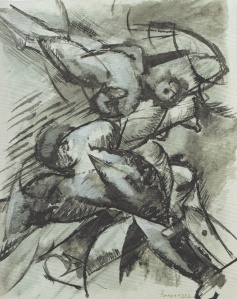
I Want to Fix Human Forms in Movement, Dynamic Scomposizione by Umberto Boccioni. (Charcoal and watercolor on paper. 1913. Civico Gabinetto die Disegni-Catello Sforzesco, Milan.)
When he tried to work out a more organic way to represent motion Boccioni kept reverting to lines indicating direction of motion or, perhaps, ripples in the medium in which the motion is taking place. The lines of movement are evident from photographic exposures of movement (which Futurist Bragaglia was experimenting with at the time, see below), but that is an artifact of the way film captures light exposure. It is not convincing in synthetic representation. In his famous bronze Unique Forms of Continuity in Space, part of the Met’s permanent collection, wind trails behind the form of an advancing figure much like wings appeared in classical versions of Hermes. The heaviness of the bronze, however, makes the trails much too prominent and the effect is not so much a representation of movement as a stylization of a form in a modified Cubist manner.
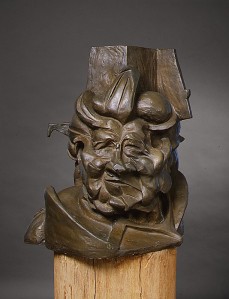
Antigraceful by Umberto Boccioni (Bronze. 1913 (cast 1950-51). Metropolitan Museum of Art.) One of many representations of Boccioni’s mother. Although he uses cubistic application of planes, Boccioni attempts to incorporate the Futurist theory on perception by having a building merge with the back of her head.
A different problem arose from Boccioni’s attempt to show the Futurist’s view of the continuity of perceived objects. Boccioni clearly attempted to merge Cubism with the idea that objects participated with each other, the most provocative of the claims of the Technical Manifesto, in his 1913 bronze Antigraceful. Boccioni analyzed the problem from with strict Cubist principles, as is shown by his study Head + House + Light. And the bronze indeed would pass for typical Cubism in its reassembly of the form with geometric forms. The difference, and an odd one, is that Boccioni adds a bit of Futuristic contiguity notions by having a building arise from the back of the figure’s head. The effect of the Cubist re-assembling and the Futurist contiguity notion is not particularly successful, not the least of which comes from the three-dimensional nature of the figure. Futurist notions of contiguity of objects results from the perception of a fixed observer. When one walks around the Antigraceful work, the contiguity of the building with the head seems an affectation, because we are no longer seeing the objects in relation to each other from the same position.

Dynamism of a Cyclist by Umberto Boccioni. (Oil on canvas. 1913. Gianni Mattioli Collection, on long-term loan to the Peggy Guggenheim Collection, Venice.)
It was not until Boccioni relented on a literal representation of motion and a mechanical approach to contiguity that he was able to show natural motion in less than an artificial way. His drawing I Want to Fix Human Forms in Motion, though it still retains traces of lines suggestion the direction of movement, begins to portray movement organically by the nature of the composition. Cubism still dominates the technique but Boccioni shows a tendency toward a more abstract rendering of objects overall and the demonstration of movement specifically. When we reach his Dynamism of a Cyclist, we see a decisive step towards abstract depiction of motion. No longer does Boccioni rely on drawn indications of direction. In fact it is the position of the figure itself which suggests motion. The arrangement of color provide the modeling of the figure so that Boccioni no longer has to rely on explicit Cubist techniques. The result is why at first sight appears to be a flat abstraction, and becomes a moving figure when the viewer is able to put together in his mind the relation of all the parts. Boccioni would continue to push toward more abstraction in his depiction of the dinamismo at the heart of the original Futurist programme.
Gino Severini, one of the last two of the original Five (along with Giocomo Balla), was also the one more deeply entrenched in Cubism. Severini had known Boccioni from the beginning of the century and both visited Balla’s studio to see his concept of Divisionism. Both would formally study with him. In 1906 Severini moved to Paris where he became absorbed with Cubism but also other forms of French New Art including Fauvism, as can be seen by his 1911 painting Memories of a Trip. When others of the group visited him there he enthusiastically explained to them the tenets of Cubism and also taught them about Parisian nightlife. The latter lessons never interested the other Futurists who were much too intent on anticipating the future and more intrigued with technology to waste thought on human debauchery.
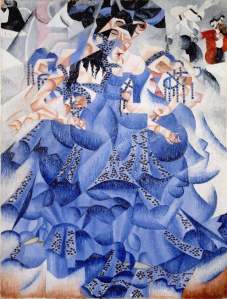
Blue Dancer by Gino Severini. (Oil on canvas with sequins. 1912. Gianni Martioli Collection, on long-term loan to the Peggy Guggenheim Collection, Venice.)
Nevertheless, it was Severini, using Cubist techniques and depicting an oddly (for a Futurist) joyous human celebration, who produced the first successful merging of Cubism and the aspirations of the dynamics of Futurism. Severini’s Blue Dancer is the first brightly colored work in the exhibit and also the first of very few representing pure physical gaiety. Although Boccioni and Carrà both had begun using swirls and bolder colors in representations of crowd scenes, Severini’s Blue Dancer is the first work of any of the Futurists that looks like a fully realized Futurist artwork and not an experiment or study in search of a realized aesthetic. Much of the effect is through the use of arcs and cylindrical shapes at discordant angles. This effect creates a three-dimensional look at the bottom while the dancer’s head merges (contiguously) with the other dancers, the crowd and the background.

Simultaneous Visions by Umberto Boccioni. (Oil on canvas. 1911. Von der Heydt-Museum, Wuppertal, Germany.)
Boccioni was much influenced by Severini as can be seen by comparing his Simultaneous Visions with Severini’s Memories of a Trip. In fact Simultaneous Visions in concept, overall subject matter and effect seems to be a precursor to his famous The City Rises (1910) (part of the permanent collection of the Museum of Modern Art). The latter painting is a large canvas, which essentially begs to be considered a manifesto in its own terms. And although the workers float into the city (much like the viewing heads in Simultaneous Vision), evidently to labor at the factory in the background around the corner of which the sun beams, the city itself is rendered in more-or-less conventional perspective and there is really no sense that the perception principles of the Futurist Technique Manifesto were applied.
Carlo Carrà’s 1910-11 Funeral of the Anarchist Galli, also at the MoMA, is more aligned with the goals of presenting a moving scene as part of a whole, with objects absorbed into each other. Carrà also, like Severini, uses circling lines to show movement. But again, it is a fairly conventional approach, the “merging” of the figures coming about by reason of chaotic movement and shadows. This piece does, however, show that Futurism need not have become a politically reactionary movement. The painting depicts the funeral of an anarchist killed in 1904 during a labor strike. The police fearing that the occasion would provide leftists and anarchists the opportunity to demonstrate barred the public from the cemetery. When the protestors balked, the police came down in force. Carrà, a leftist himself, painted the scene from personal experience. But Carrà’s politics never penetrated Futurism, which would be steered by Marinetti to the end. In any event, Italian progressives, including Carrà diverged from other European leftist, by clamoring to join the Great War (see below). That fundamental break with prevailing Western radicals, allowed the Italian left to Italian left to carry on a dalliance with Fascism which preached a mangled form of socialism.
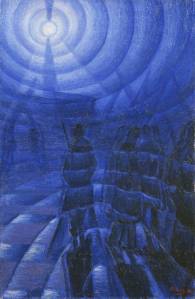
Solidity of Fog by Luigi Russolo. (Oil on canvas. 1912. Gianni Mattioli Collection on longterm loan to the Peggy Guggenheim Collection, Venice.)
The other two members of the Five began from a more conservative starting point. Balla, the oldest of the group, was already established as a Divisionist, a neoimpressionist technique which separated light into separate swathes of color which, when placed in appropriate proximity, produced, they thought, the most faithful representation of light possible. Balla taught the technique to both Boccherini and Severini at the beginning of the century. Balla’s Street Light (above) was a late example of the school. The circularity of the v-shaped swathes surrounding the lamp (and blocking by greater luminosity the light of the moon) simulates motion. Russolo was influence by this depiction of light, and while Russolo was probably the least innovative of the Five, once he learned his lessons he was able to use techniques to create inviting compositions. (Perhaps it is because Russolo retained all those things that the Futurists claimed to want to throw out (composition, harmony, balance, proportion, etc.), that make his works are pleasing. “Pleasing,” however was never a state aspiration of Futurists.) In Suburb-Work, there is no movement visible at all. But the light diffused through flecks of smoke are the result of the human activity in the factory buildings. This is not Futurism according to the manifests. Nor is Solidity of Fog. But the effect is near: Here it is light that pulsates, enough to actually affect the “figures” before the light. The light is traveling on something like ether: the fog.
It is the depiction of motion as a pure abstract that Balla and, through his influence, Russolo were after. While Boccioni was experimenting on how a horse or a cyclist interacted with their surroundings during motion, Balla was reducing speed to lines and waves. Speeding cars (above left) were successively reduced until they became paths of movement (above right). He would eventually produce paintings simply of abstract speed with other abstractions (such as noise).

The Hand of the Violinist (The Rhythms of the Bow) by Giacomo Balla. (Oil on canvas. 1912. Eastorick Collection, London.)
Thus Boccioni and Bella had nearly opposite technical approaches to motion. But both approaches were informed by photography. Anton Giulio Bragaglia joined the movement taking exposures common motions, such as hands typing on typewriters and a man striking a cigarette. The exposure of the film seemed to deform the figures (Boccioni’s approach), while they also created abstract lines (Balla’s approach). Bragaglia formally declared his unity with the Futurists in the usual way, with a manifesto on Fotodinamismo. Bragaglia would go on to make Futurist theater and cinema. Balla believed that Bragaglia’s work validated his own question for the representation of pure motion, and he even tried to imitate the photographic view in his oil The Hand of the Violinist.
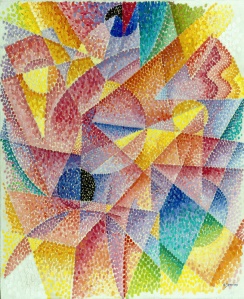
Spherical Expansion of Light (Centripetal and Centrifugal) by Gino Severini. (Oil on canvas. ca. 1914. Munson-Williams-Proctor Arts Institute, Utica, New York.)
The two approaches to motion of Balla and Boccioni never produced a breach among the original Five. In the end both approaches tended towards a form of abstraction very much identical to each other’s. In the new emerging abstraction around 1914 Severini was able to reach back to Divisionism to color his Cubist abstract depiction of the movement (in both directions) of light.
Polemics did not disturb the original Five, who had relations before their Manifesto. There was hesitation, however, to admit new artists into the group, especially because most other Italian artists had taken position against the movement. There were the usual objections raised competing groups of self-styled revolutionary artists have with each other for deviating from revolutionary dogma. I will not trace the literary battles for and against the Futurist arts (which even involved Carrà and Boccioni physically assaulting a hostile critic named Ardngo Soffici, a polemicist and one-time Cubist, except to note that in February 1913, the Futurist exhibition in Rome (a new venue at the insistence of Marinetti) included nine works by the very same Ardengo Soffici, who produced works of what was then orthodox Futurism. He would create a new critical journal Lacerba, where he explained how Futurism has reconciled itself to both Cubism and Impressionism and that explained his own acceptance of the Italian movement. Soffici would much later prove to be an unreliable convert, even by Fascist standards, when he tried to persuade Mussolini to ban modernism (as Hitler had in Germany) and include Futurism in the list of degenerate art. Mussolini refused because by the late 1930s Futurism had deeply imbibed Fascism and had become, if not the official art form, at least its usual style.
The Great War and New Blood
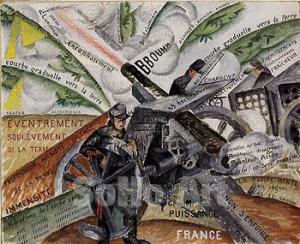
Cannons in Action by Gino Severini. (Oil on canvas. 1915. MART. Museo di arte moderna e contemporanea di Trento e Rovereto, Italy.)
The war would completely transform Futurism from an avant-garde coterie to a political-art movement with ambitions to represent the material national culture of Italy. Marinetti, of course, had pined for war since the beginning, claiming it would be a “red vacation.” When the Great War broke out, the Futurists were at the vanguard of those urging Italy to join the Triple Entente. Their nationalist reason for intervention was the desire to recover Trieste from the Austro-Hungarian Empire. This was a political aim of Marinetti’s for a long time, and one for which he spent time in jail. The Futurists unleashed provocative public “theater” in support of intervention, much like their earlier seratas, which brought them to the fore in the first place. Marinetti met Mussolini, a fellow war-monger, during this intervention campaign. One demonstration netted Boccioni, Carrà. Marinetti and Russolo six days in jail. But in the end they could claim success because Italy joined the war in 1915. A number of Futurists, including Boccioni, joined with Marinetti in the Lombard Battalion of Volunteer Cyclists and Automobilists.
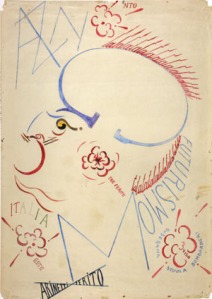
Marinetti Injured by Francesco and Pasqualino Cangiullo. (Colored ink on paper. 1917. Collection of Luce Marinetti, Rome.)
In the summer of 1916 Boccioni died, not heroically, but accidentally in a fall from his horse. The following spring Marinetti was wounded by grenade shrapnel. He was able to rejoin his unit later that summer. He was even able to participate in the final Italian victory at Vittorio in October 1918. In all, the war was just the holiday he supposed, and he left everyone know that. His insouciant attitude toward his service as well as his wartime injury greatly enhanced his reputation among Futurists. He was now firmly in control of all of the Futurism, not just an adviser. Marinetti joined the Fascist Party shortly after the war. For the painters this point was something of a sea change, for Futurism stopped being an art movement and became a broad multi-media socio-politico-cultural movement. With its popularity came a simplification of the approach, a more crowd-pleasing aesthetic. The use of the movement to shock and awaken the nation was over, perhaps because Marinetti had the war he desired. In any event humor emerged and the movement began to enter areas that it had never explored before.
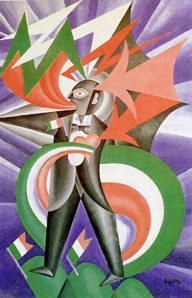
Stormy Patriot Marinetti: Psychological Portrait by Fortunato Depero (Oil on canvas. 1924. Private Collection.) In the exhibition this piece is show in the artist’s frame.
Chief among the artists who accomplished the transformation was Fortunato Depero. Depero was originally destined to be a minor craftsman in the Tretino provide of Northern Italy. His fine arts career having been thwarted by his rejection by the Akademie der bildenden Künste Wien, he returned to Rovereto where he was serving his apprenticeship as a marble worker in the studio of the sculptor Pietro Canonica, when in 1913 he read a polemic by Marinetti (in Lacerba, the journal published by Soffici). It was literally a life-changing event. He moved to Rome to take up the call to cultural arms, and there he met Balla and became active in Futurist circles. He quickly was invited to participate in Futurist art exhibitions. Depero became so central to the movement by 1915 that he and Balla authored The Futurist Reconstruction of the Universe in March. They cataloged the Futurist manifestos in painting, sculpture, polemic poetry (Marinetti’s words-in-freedom) and noises and vowed “to realize this total fusion in order to reconstruct the universe making it more joyful, in other words by a complete re-creation.”
We will give skeleton and flesh to the invisible, the impalpable, the imponderable and the imperceptible. We will find abstract equivalents for every form and element in the universe, and then we will combine them according to the caprice of our inspiration, creating plastic complexes which we will set in motion.
They promised to infuse everything with the principles of Futurism and to create new objects solely from combining elements of Futurism. Toys, for example, would be designed to produce spontaneous laughter, to encourage creativity, to elicit continual exercise and to accustom the child “to physical courage, to fighting and to war.”

From a series of 8 Rhinoceros. (Painted wood. Remade 1923. MART, Museo di arte modern e contemporanea di Trento e Rovereto, Italy.)
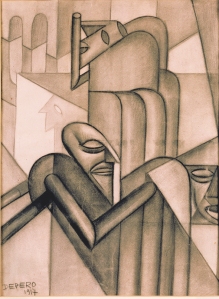
Mystical Silence by Fortunato Depero. (Charcoal on paper. 1917. MART, Museo di rate modern e contemporanea di Trento e Rovereto, Italy.) One of a series of drawings for Gilbert Clavel’s An Institute for Suicides.
Depero’s exploration of set design for ballet further expanded his range. In 1916 Diaghilev (who was living in Rome at the time) commissioned Depero to design the sets for Stravinskys ballet The Song of the Nightingale. Although the sets were never used, the connection drew Swiss-born Egyptologist, writer and eccentric Gilbert Clavel (a hanger-on among Diaghilev’s circle) to Depero. Clavel was attracted to Futurism because it was composed of vague metaphysics tinged with science and technology, much like his own thinking. He asked Depero to illustrate his quirky book of black humor, An Institute for Suicides. Holed up in a villa on the island of Capri, Depero imbibed Clavel’s genuine knowledge of ancient mysteries and his dilettante’s accumulation of modern ones, and Depero dashed off numerous sketches for Clavel. The combination of heady metaphysical discussion and the luxurious isolation of the island proved not only a goad for work but also an impetus for a new synthesis of influences for Depero. It was as a result of this extended work-holiday that Depero again reintegrated Cubism into the dynamic-plasticity which was the summary of Futurism proclaimed by Balla and him.
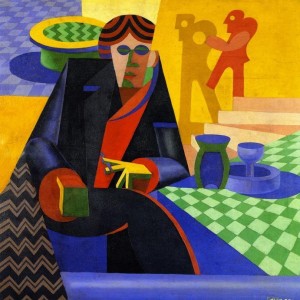
Portrait of Gilbert Clavel by Fortunato Depero. (Oil on canvas. 1918. Museo civico d’Arte contemporanea, Milan.) This work is not shown in the Guggenheim exhibit.
Depero’s oils during this period (which are not among the works at the Guggenheim exhibit) show these elements as well as the older Futurist attraction to bold color. Portrait of Gilbert Clavel represents a simplification of both Futurism and Cubism and moves away from pure art to the realm of design. His numerous portraits of Clavel shows his admiration for the man. Depero collaborated with Clavel in one final project: a new form of theater.
Depero had been influenced by Clavel’s understanding of myth and of course all Futurists had an innate propensity for theatre harking back to the original seratas and the agit-prop of the Futurist pro-interventionist publicly stage demonstrations. In addition, the teachings of Sorel on crowd response to performance of myth had considerable effect on the thinking of the Futurists, just as Sorel had on other right-leaning avant-garde movements in England and France. Depero, however, was responsible for the playfulness of the effort.
The production Depero and Clavel created was multi-media but it had no actors or dancers. Instead Depero created wooden marionettes. It was set to the music of a number of composers, possibly even Bartók (although that attribution is uncertain). There were no spoken words and the pantomime and dance were presented in five short scenes. The puppets were not especially prominent, given Futurist theory; instead, lights, scenery, music, and story were to receive equal emphasis. The 11 performances of My Balli Plastici in Rome’s Teatro del Piccoli in April 1918 received little critical acclaim, but Marinetti was more than pleased. Futurism had conquered another form of expression. There seemed no limit to his manifesto. Futurism would even conquer Diaghilev, but it would be Balla who designed the elements for Stravinsky’s five-minute piece Fireworks. The Guggenheim exhibition contains sketches of the set an a video realization of the light show (again no actors or dancers) produced by the Carnegie Mellon University Entertainment Technology Center.
Toward a Fascist Future

Numbers in Love by Giacomo Balla. (Oil on canvas. 1920-23. MART, Museo d’art modern e contemporanea di Trento e Rovereto, Italy.)
Alone among the participants in the Great War, Italy emerged almost triumphant. Italy achieved its territorial goal of Trieste and suffered relatively little bloodshed to obtain it. The fledgling nation-state had acquitted itself respectably in the war, and there was no great national introspection afterwards. The 1920s would prove a time of unaccustomed well-being for the Italians, and the nationalist good feeling was reflected in Futurism which became essentially the national culture, reflecting and promoting popular cultural themes. As Italy became a Fascist State, Futurism became its unstinting promoter. Futurism was everywhere. Decorations, middle brow entertainment, toys, flat ware, coffee settings, tea sets, sports wear (for women!), vests and suits. In 1919 Depero founded a Futurist manufactory of sorts in Rovereto, which produced toys, tapestries and furniture. Balla also continued to make Futurism bourgeois-friendly, and soon the entire project looked very much like product design.
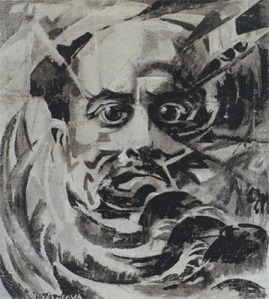
Marinetti by Růžena Zátková. (Tempera on canvas. ca. 1921. Private collection.) In the exhibition this work is shown in the artist’s original metal frame.
In the meantime Marinetti kept his thumb on all aspects of the movement, deciding what was and what was not orthodox Futurism. He also was pumping his Fascist colleagues for promotion. But Mussolini had no interest in art and allowed all comers to occupy whatever field they chose. It mattered little to him—he did not consider himself an artist as Hitler did, and in any event all Italian art schools promoted Fascism with equal ardor.
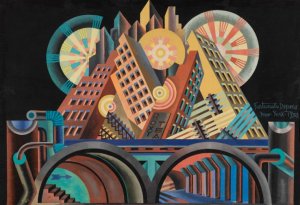
Skyscrapers and Tunnels by Fortunato Deperto. (Tempera on paper. 1930. MART, Museo di arte moderna e contemporanea di Trento e Rovereto, Italy.)
Depero would move to New York City in 1928. There he must have imbibed the reductio ad commercio of the place. In any event he was thoroughly successful at stage design and consumes and he took up graphic design, creating covers for such magazines as The New Yorker and Vogue. He also did interior design work for two restaurants and even worked for Macy’s. On his return to Italy in 1930 his paintings lacked the original dinamismo sought out by the founders and instead replaced it with a patterned representation of commerce as movement. Depero eventually settled for advertisement as art, and he lives on today in his graphic work for his client Campari.,
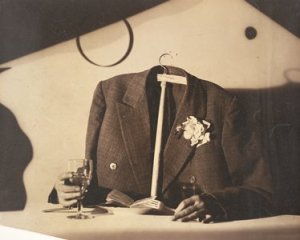
The Perfect Bourgeois, Camouflage of Objects by Tato (Buglielmo Sansoni). (Gelatin silver print. 1930. Rovereto, MART.)
The new Futurists of the late 1920 and 1930s were dedicated Fascists, believing in Mussolini as the “new man,” and Marinetti as his John the Baptist. The art they offered glorified the work of the Italian nation, and machines in particular. Among the unique offerings of this new set was aerodinamismo, which consisted of photographs from airplanes in motion, particularly swirling motion. Architecture became a large part of Futurism, particularly as the Fascist state conferred its benefit on the adoring Futurist artists. All the while, the human was squeezed out of the picture. Human achievements were celebrated, but the humans themselves were not. Futurism remained a revolutionary art form of sorts, flogging the bourgeoisie while catering to it, but it was not the same movement that began with the manifesto decrying artists who “endlessly exploited the glories of the ancient Romans.” For in their glorification of the Fascists, who saw themselves as the modern imperial Romans in every way, they became the very thing that they rebelled again. Futurism died in 1944 with its Fascists models.

Central panel of triptych Fascist Synthesis by Alessandro Bruschetti. (Oil on plywood. 1935. Wolfsonian–Florida International University, Miami Beach, Florida.)
* * *
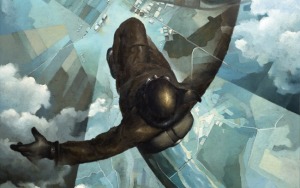
Before the Parachute Opens by Tullio Crali. (Oil on panel. 1939. Casa Cavazzini, Museo d’Arte Moderna e Contemporanea, Udine, Italy.)
The Guggenheim exhibit of these works is about as exhaustive a presentation as could be made, and probably more than most would want. It aims to represent the original motivations, to “recreate the universe” and to put the viewer in the center of the art. The exhibition not only has the usual paintings, drawings, photographs and three-dimensional works (including furniture, ceramics, clothing, and the like), but it also exhibits videos of rarely seen Futurist cinema and film of Futurist declaimers, including Marinetti. The walls are covered with original manifestos and the graffiti-like words-in-freedom. Even in the most serene parts of the exhibit, it is hard to get away from the political, confrontational impulses of Marinetti and his closest admirers. It is difficult to view many objects before you encounter something that proclaims its Fascist sympathies, particularly as time goes on in this chronological exhibition.
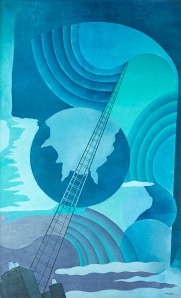
Synthesis of Radio Communications by Benedetta (Benedetta Cappa Marinetti). (Tempera and encaustic on canvas. 1933-34. Palazzo dell Poste di Palermo, Sicily.)
this movement have been less strident and less anti-humanist if there has been no Fascism in Italy? Would it have sputtered out into commercial self-parodoy as Depero seemed to be driving it? It’s hard to tell. Whatever demons drove Marinetti and the founders to adopt war-mongering as an ideal and caused their violent distaste for women and humanism also produced the Fascists themselves. So there is probably no way to separate the two. Nonetheless, despite the political content of other works, many of the earlier pieces show an interesting and novel way of looking at the world. The innovations of the early Futurists probably had no political content. The glorification of the machine and of Fascist order of the later Futurists probably would have happened had there been no Futurist movement at all. This is not to excuse the part they played in bringing misery to Italy and the world, it is simply to avoid overstating the responsibility of these artists for the work of those with greater power and greater cruelty. Art and society are woven of the same cloth and often, as here, art gives insight into how societies bring things upon themselves for good or evil.
The exhibit runs until September 1, 2014. The accompanying catalog, Italian Futurism 1909-1944: Reconstructing the Universe edited by Vivien Green contains a wide variety of discussion on the range of activities of Futurists, not just in the visual arts but in music, cinema, crafts and designs as well as politics. It is a book well worth pursuing, even if you are not deeply interested in the movement, because it treats the thorny question of how art and justice interact and provokes questions about who ought to be responsible for what.

